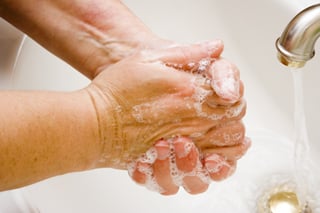“Compulsive” and “obsessive” have become everyday words. “I’m compulsive” is how some people describe their need for neatness, punctuality, and shoes lined up in the closets. “He’s so compulsive is shorthand for calling someone uptight, controlling, and not much fun. “She’s obsessed with him” is a way of saying your friend is hopelessly lovesick. That is not how these words are used to describe Obsessive- Compulsive Disorder or OCD, a strange and fascinating sickness of ritual and doubts run wild. OCD can begin suddenly and is usually seen as a problem as soon as it starts.
Compulsives (a term for patients who mostly ritualize) and obsessions(those who think of something over and over again) rarely have rituals or  thoughts about neutral questions or behaviors. What are their rituals about? There are several possible ways to list symptoms of OCD. All sources agree that the most common preoccupations are dirt (washing, germs, touching), checking for safety or closed spaces (closets, doors, drawers, appliances, light switches), and thoughts, often thoughts about unacceptable violent, sexual, or crude behavior. When the thoughts and rituals of OCD are intense, the victim’s work and home life disintegrate. Obsessions are persistent, senseless, worrisome, and often times, embarrassing, or frightening thoughts that repeat over and over in the mind in an endless loop. The automatic nature of these recurrent thoughts makes them difficult for the person to ignore or restrain successfully.
thoughts about neutral questions or behaviors. What are their rituals about? There are several possible ways to list symptoms of OCD. All sources agree that the most common preoccupations are dirt (washing, germs, touching), checking for safety or closed spaces (closets, doors, drawers, appliances, light switches), and thoughts, often thoughts about unacceptable violent, sexual, or crude behavior. When the thoughts and rituals of OCD are intense, the victim’s work and home life disintegrate. Obsessions are persistent, senseless, worrisome, and often times, embarrassing, or frightening thoughts that repeat over and over in the mind in an endless loop. The automatic nature of these recurrent thoughts makes them difficult for the person to ignore or restrain successfully.
The essence of a Compulsive Personality Disorder is normally found in a restricted person, who is a perfectionist to a degree that demands that others to submit to his\her way of doing things. A compulsive personality is also often indecisive and excessively devoted to work to the exclusion of pleasure. When pleasure is considered, it is something to be planned and worked for. Pleasurable activities are usually postponed and sometimes never even enjoyed. With severe compulsions, endless rituals dominate each day. Compulsions are incredibly repetitive and seemingly purposeful acts that result from the obsessions. The person performs certain acts according to certain rules or in a stereotypical way in order to prevent or avoid unsympathetic consequences. People with compulsive personalities tend to be excessively moralistic, and judgmental of themselves and others. Senseless thoughts that recur over and over again appearing out of the blue; certain “magical” acts are repeated over and over. For some the thoughts are meaningless like numbers, one number or several, for others they are highly charged ideas-for example, “I have just killed someone.” The intrusion into conscious everyday thinking of such intense, repetitive, and to the victim disgusting and alien thoughts is a dramatic and remarkable experience. You can’t put them out of your mind, that’s the nature of the obsessions. Some patients are “checkers,” they check lights, doors, locks-ten, twenty or a hundred times. Others spend hours producing unimportant symmetry. Shoelaces must be exactly even, eyebrows identical to each other. A case studied by the well-known art therapist, Judith Aron Rubin, Rubin tells of a young girl named Mary, who suffers from OCD, and how she drives her fellow waitresses frantic because she goes into a tailspin if the salt and pepper she has arranged in a certain order has been moved around. All of the OCD problems have common themes: you can’t trust good judgment, you can’t trust your eyes that see no dirt, or really believe that the door is locked. You know you have done nothing harmful but in spite of this good sense you must go on checking and counting.
There are many, many common obsessions, of all of them the most common is called “washing” this involves the victim to have a constant feeling of contamination, dirt and\or grime all over their body. The book, The Boy Who Couldn’t Stop Washing by Judith L. Rapoport describes a long, sad case of a young boy who spent three or more hours in the shower each day. The boy “felt sure” that there was some sticky substance on his skin. He thought of nothing else. Our normal functioning probably consists of constant uncountable checking, a sort of radar operation, that we could not do consciously and still act efficiently. Something has gone wrong with the process for obsessive compulsives, the usual shut-off such as “my hands are clean enough” or “I saw the gas was turned off on the stove” or “The door was locked.” does not get through. Everyday life becomes dominated by doubts, leading to senseless repetition and ritual. Obsessive phobias tend to have distinct features. According to Issac Marks, “They are usually part of a variety of fears of potential situations themselves. Because of the vagueness of these possibilities, ripples of avoidance and protective rituals spread far and wide to involve the patient’s life style and people around him\her. Clinical examination usually discloses obsessive rituals not directly connected with the professed fear; instead the obsessive fear is part of a wider obsessive-compulsive disorder.”(Marks,1969) “The sustained experience of obsessions and\or compulsions.” make up what the American Psychiatric Association’s Diagnostic and Statistical Manual of Mental Disorders, 3rd edition, calls Obsessive-Compulsive Disorder. It has also been called obsessional neurosis. Psychiatrists have been fascinated by this disorder for over a hundred years. Priests have described symptoms like these for much longer than that.(A.P.A.,80)
Children suffer from OCD with exactly the same symptoms as adults. Normally an early start in mental disorder is unusual. Other mental  illnesses, such as depression or schizophrenia often appear in a different form in young children and in any case are much more rare in children than in adults. But with OCD it is the same at any age.
illnesses, such as depression or schizophrenia often appear in a different form in young children and in any case are much more rare in children than in adults. But with OCD it is the same at any age.
To quote the author and psychiatrist, Judith L. Rapoport, “The disease affects some of the most able, sensitive, and talented people I have met. Their otherwise normal ability to function, to become a good husband, wife, or friend makes working with obsessive-compulsive patients very rewarding and, when they are severely ill, very painful.”(Rapoport,’89, p.3) A few individual cases of OCD have been reported in the medical literature over the past 150 years, but only recently have we learned of the large number of adolescence and adults who suffer with it. More than 4 million people in the United States suffer from its’ disabling thoughts or rituals. Amazingly most of them keep their problem hidden. We are finding out that many of the adults who are being treated for it now went pretty much their whole life hiding the problem because they were too humiliated or did not want to be considered crazy and thrown in a mental institution. In spite of the interesting individual cases of OCD in the past one hundred fifty years, there was not much work on treatment.
There is little incentive to evaluate or develop new treatments for rare disorders. So up until the 1970’s the recommended treatment was psychotherapy or psychoanalysis. Doctors made these suggestions for lack of an alternative, but severe cases and follow-up studies of adults could not show any advantage for this treatment. The Best studied Drug to reduce or stop OCD,is called Anafranil. Anafranil was first put on the market in 1990. The side effects of Anafranil range from mild to severe. The most common side effects are dry mouth, constipation, and drowsiness. However a tremor, loss of sexual appetite, impotence-which is temporary until you stop taking the drug, and excessive sweating can be major problems. These are all side effects common to tricyclic anti-depressants-the group of which Anafranil belongs.
